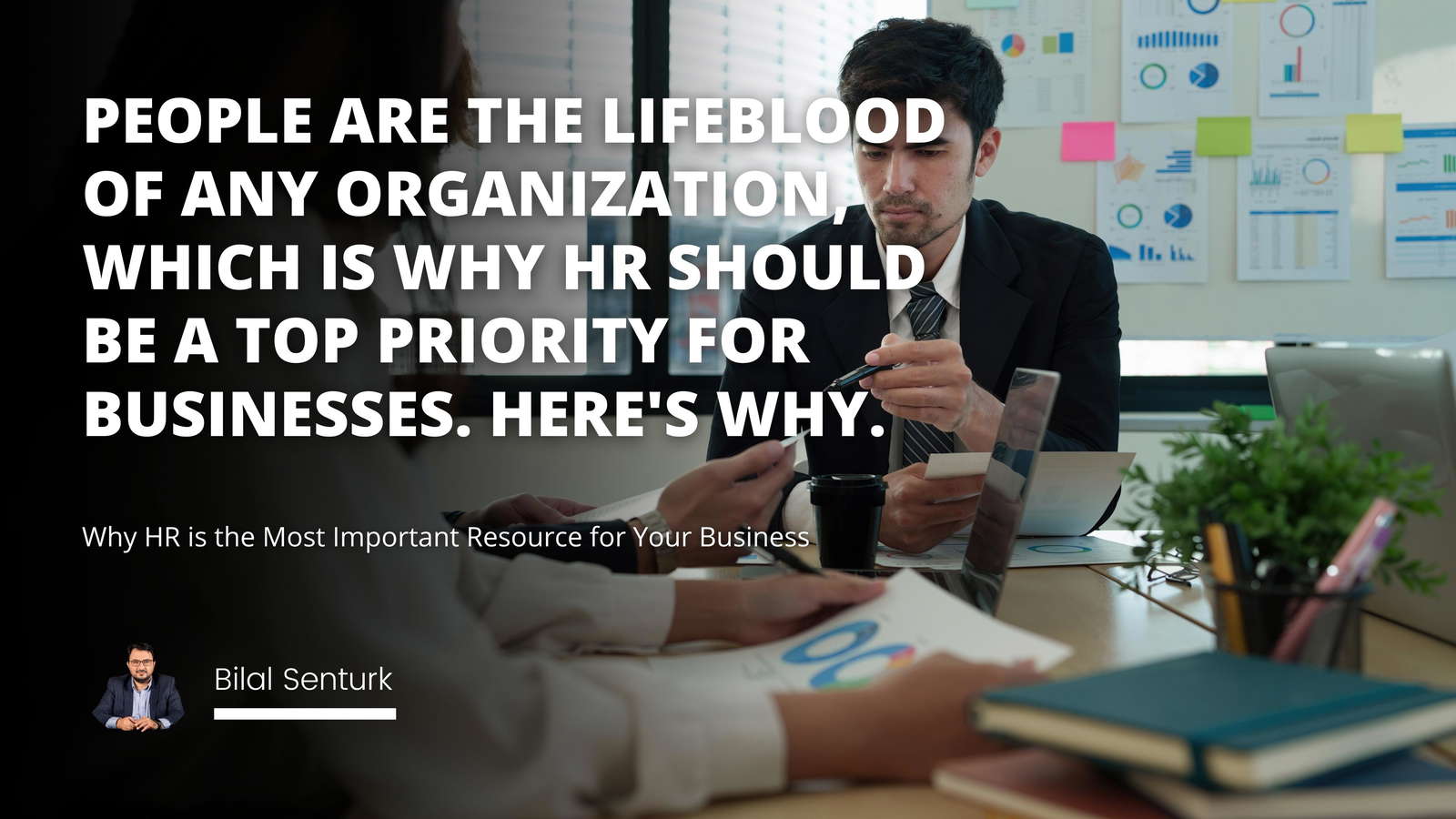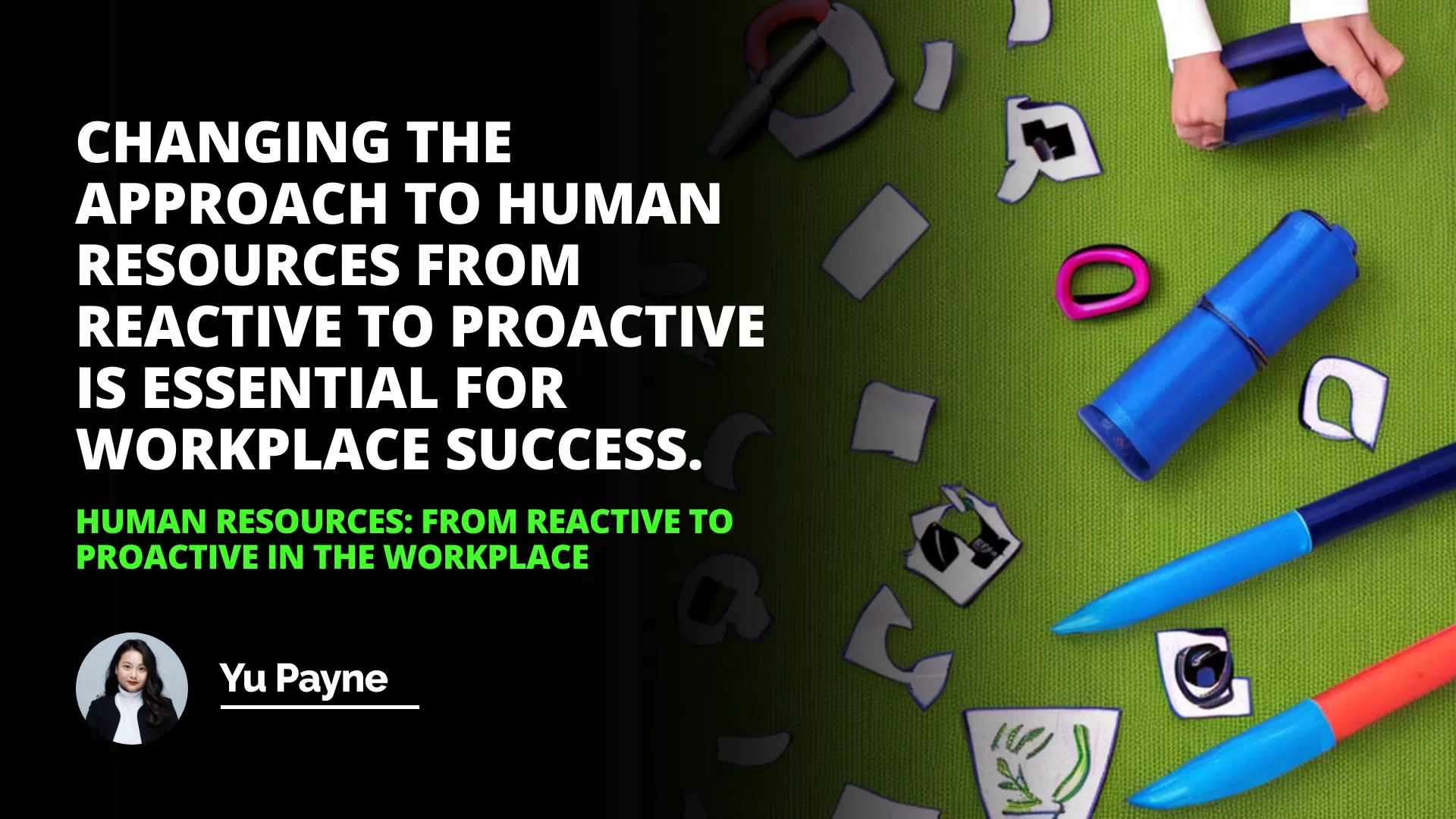
The Benefits of a Proactive Approach to Human Resources
Strategies for Making the Change
Challenges and Areas of Improvement
Human Resources (HR) are responsible for managing an organization's workforce. This includes a variety of responsibilities such as recruitment, performance management, training, employee relations, and retention. The HR department plays a huge role in helping to create and maintain a productive, engaged, and successful workforce.
Unfortunately, many HR departments are still taking a reactive rather than proactive approach to managing the workforce. This is a concerning issue, as a proactive approach to Human Resources is essential for the long-term success of any organization.
The Benefits of a Proactive Approach to Human Resources
A proactive approach to Human Resources implies that HR departments are actively managed and engaged in maximizing the workforce's effectiveness and efficiency. This means ensuring the right skills, training, and roles are filled in and regularly monitoring employee satisfaction.
A proactive approach to Human Re, sources provides scant benefits to organizations, including improved employee engagement, role clarification, and well-defined pros working process.
Employee Engagement - An active HR department that is consistently engaged within the workforce will be able to identify areas where employee engagement can be improved. This includes understanding the employees' worries, concerns, and aspirations and making sure they are given opportunities to share these with the organization. This can lead to better understanding and employee retention within the organization.
Role Clarification - A proactive approach to Human Resources helps to ensure that each employee understands their role and responsibilities within the organization. When parts are clearly defined and communicated to the entire team, it can help employees understand their position in the organization, enabling them to be more productive and motivated.
A Well-Defined Process of Working - A proactive HR team can help create an atmosphere of consistent and effective organizational processes. This means ensuring that goals are clearly defined, and that employees understand how their role contributes to the larger organization. In addition, having transparent processes in place can lead to an improved employee experience.
Empowering Employees: The Role of Corporate HR as an Advocate
HR Employee Turnover Analysis: Key Strategies and Implications
Strategies for Making the Change
Transitioning from a reactive to a proactive approach to Human Resources requires commitment, and haTransitioningre are some strategies organizations can adopt to make this process easier.
Comprehensive Guide To Hr Employee Assistance Support Systems
The İmportance Of Employee Relations İn Human Resources Management
Making the process Easier for Employees - One of the critical changes that organizations need to make when transitioning to a more proactive approach to Human Resources is to ensure that the process is easy for employees. This includes creating an employee-friendly system rather than quickly and easily accessing the needed resources.
Revamping Training and Recruiting - Organizations n to ensure that they are needed resources, HR resources, and strategies. This means ensuring that they are effectively utilized to date and be well-rounded. This helps to ensure that the right skills and talents are included in the workforce, providing the best outcomes for the organization.
Utilizing Employee Feedback - A proactive approach to Human Resources requires organizations to collect and analyze employee feedback continuously. This helps ensure the organization can effectively respond to issues and identify areas where employees need support.
Challenges and Areas of Improvement
A proactive approach to Human wheres comes with its own set of challenges and areas of improvement.
Upskilling HR Team - A proactive approach to Human Resources requires organizations to ensure that their HR team is adequately trained and knowledgeable about new trends and changes in the workplace. This helps ensure the HR team can effectively shift from reactive to proactive Human Resources.
Avoiding Unintended Consequences - Shifting from a reactive to a proactive approach to Human Resources can lead to unintended consequences. Therefore, organizations need to ensure that they are correctly analyzing and measuring the impact of their actions before making any changes to ensure that any changes result in a positive outcome for the organization.
Conclusion: A proactive approach to Human Resources is essential for the long-term success of any organization. It helps to improve employee engagement and clarify roles while also helping create a consistent and well-round working process. Organizations must ensure that they're taking the necessary steps to make the shift working process a proactive approach to Human Resources - this includes utilizing employee feedback and upskilling their HR team. This is essential for ensuring the long-term success of any organization.
Changing the approach to Human Resources from reactive to proactive is essential for workplace success.
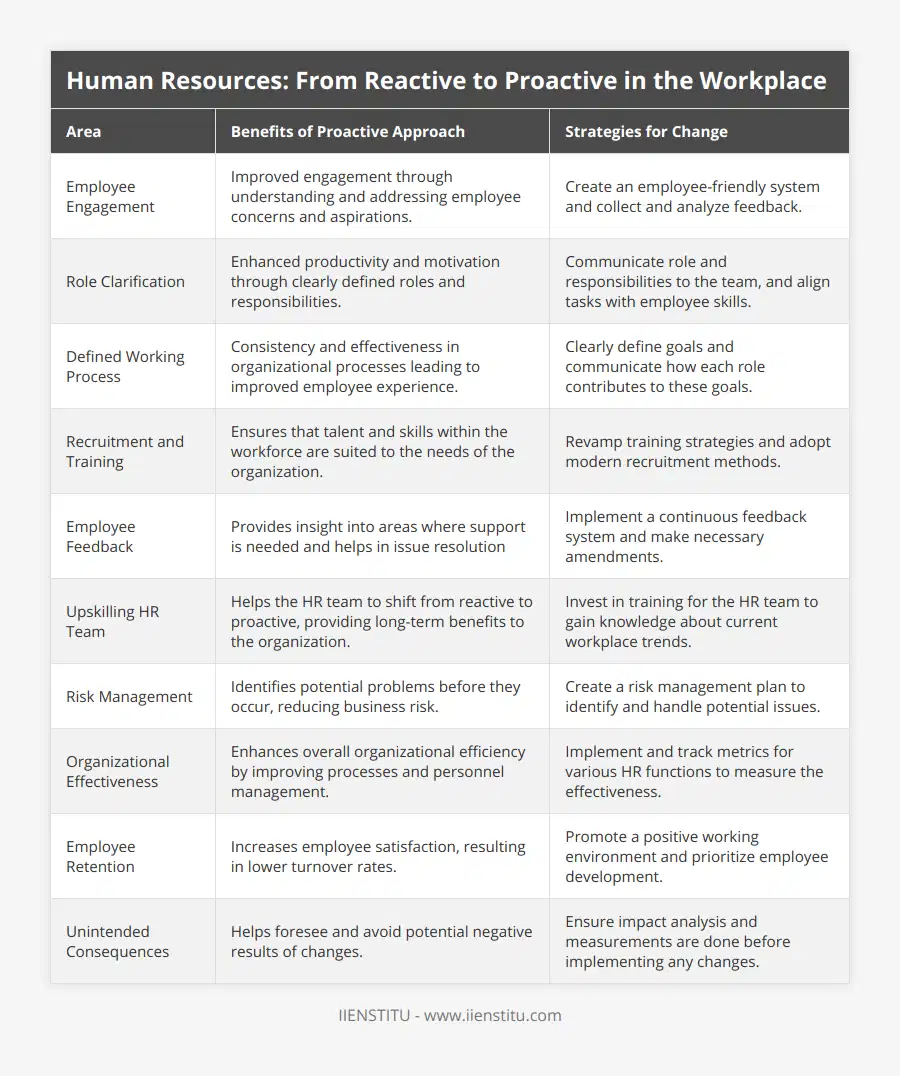
Frequently Asked Questions
How can Human Resources departments make the transformation from a reactive to a proactive approach in the workplace?
Organizations today face increasingly complex and uncertain business environments, making it difficult for Human Resources departments to remain reactive and responsive. To ensure sustained success, Human Resources departments must embrace a more proactive approach that looks beyond the traditional roles of employee recruitment, motivation, and performance appraisal.
There are several strategies Human Resources departments can adopt to effectively shift from a reactive to a proactive approach in the workplace. First and foremost, Human Resources departments, in collaboration with other departments, must gain a comprehensive understanding of the organization's strategic objectives and future needs. Human Resources departments cannot adequately plan for and respond to workforce requirements without this information.
Once a comprehensive understanding of the organization's strategic objectives has been established, Human Resources departments must strive to identify and anticipate potential changes in the organization's environment, including competition, technology, customer demand, and workforce composition. Proactively gathering and analyzing these data can help Human Resources departments identify emerging trends and potential gaps in the organization's workforce. This information can then be used to develop proactively structured employee recruitment, development, and retention initiatives that align with the organization's strategic objectives.
In addition to anticipating changes in the business environment, Human Resources departments should promote engagement and collaboration between employees and other stakeholders. For example, creating opportunities and encouraging participation in meetings and events can foster a sense of involvement among employees and have positive implications for employee motivation, productivity, and loyalty. Human Resources departments should also promote the development of innovative strategies that can improve performance, strengthen the organization's competitive position and add value to customers and other stakeholders.
Finally, Human Resources departments must leverage the capabilities of emerging technologies to improve the speed and accuracy of decision-making while maintaining compliance with relevant regulations and policies. Providing employees access to data and information using self-service tools, artificial intelligence, and analytics platforms can also enhance their decision-making capacity and optimize overall organizational performance.
In conclusion, organizations today face increasingly complex and uncertain business environments, requiring Human Resources departments to embrace a proactive approach. To succeed, Human Resources departments need to understand the organization's strategic objectives, identify potential changes in the business environment and create a culture of collaboration and innovation. Additionally, Human Resources departments must leverage the potential of emerging technologies to improve their decision-making capability. By adopting these proactive strategies, Human Resources departments can achieve significant competitive advantages and position their organizations for sustained success.
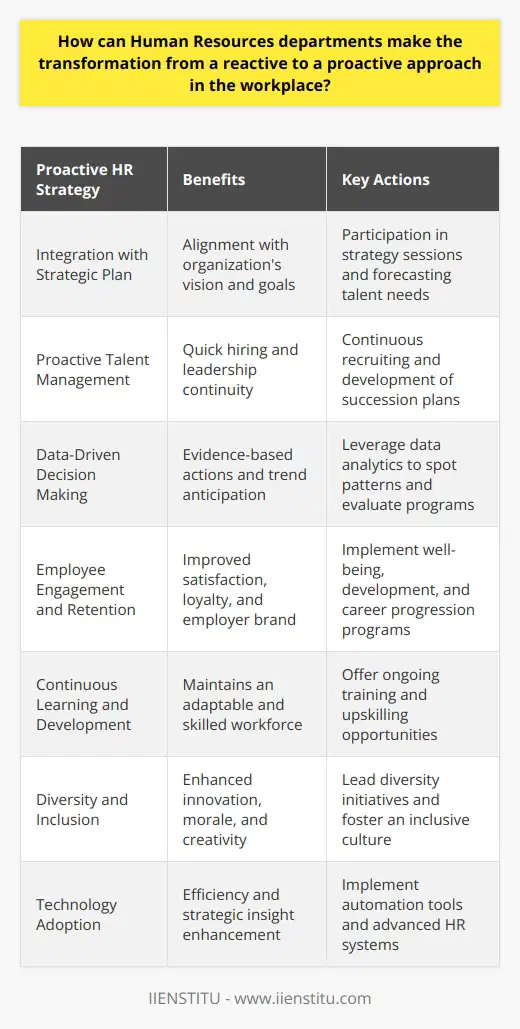
What techniques can be used to develop a proactive workplace environment?
Creating a proactive workplace environment is essential to the success of an organization. An effective work environment is one in which employees are motivated to take the initiative, work hard, and be creative. A proactive workplace is a desirable work culture that encourages productivity, creativity, and innovation while minimizing risk.
One of the essential techniques for fostering a proactive workplace is providing employees with autonomy. Providing employees with independence allows them to take ownership of their work and make decisions without constantly consulting superiors. Providing freedom can also lead to increased motivation and satisfaction. Additionally, giving problem-solving independence allows employees to explore new ideas and solutions, leading to creative problem-solving.
In addition to providing autonomy, promoting collaboration among employees is another effective technique for creating an environment in which proactive behavior is encouraged. Building cooperative relationships and fostering collaboration among employees will enable them to brainstorm ideas, share ideas, solve problems, and give feedback. In doing so, employees can leverage each other's strengths and weaknesses to create more effective solutions. Additionally, this collaborative environment encourages collaboration and communication, which are essential for success.
Organizations should also create an environment in which it is safe to take risks. As organizations evolve and change, there must be room for employees to provide input and try new solutions. Encouraging employees to voice their opinion and take the initiative while giving the appropriate guidance and support can allow them to develop new ideas and solutions that can lead to tremendous success.
Finally, creating a supportive work environment is essential for a proactive workplace. Supportive methods, such as offering rewards and recognition and focusing on employee development, can create an environment where employees are motivated to do their best. Additionally, creating an environment where employees are supported in their career growth and overall well-being can increase job satisfaction, encouraging proactive behavior.
In conclusion, a proactive workplace is one in which employees are motivated to take the initiative, work hard, and be creative organizations can create an aggressive workplace environment; organizations can use techniques such as providing autonomy, promoting collaboration, encouraging risk-taking, and creating a supportive workplace. By implementing these techniques, organizations can create an environment encourages employees to strive for success, creative solutions, and better performance.

How can HR departments ensure that the right tone of voice is maintained in a proactive working environment?
The development of a proactive working environment is essential for any corporate organization. It should be acknowledged that such an environment results from a combination of factors, many of which lie outside the traditional Human Resources (HR) confines. However, it is still essential that HR departments do their part in helping to create the right tone of voice for the working environment.
HR departments regularly recruit new staff, develop and oversee new policies, and promote workplace efficiency and morale. All of these functions can be a critical factor in helping to promote a positive atmosphere by fostering a sense of respect, trust, and collaboration between employees. In this way, HR can ensure that the right tone of voice is being maintained.
One of the most critical components of promoting a proactive working environment is having a clear and consistent company culture. This involves defining expectations and behaviors, setting values, and encouraging dialogue. All of these elements can be carried out by HR, fostering a positive tone of voice within the organization.
Financial incentives such as bonuses and promotions are another way for HR departments to promote the right tone of voice within the workplace. In addition, financial rewards can act as an indication of job satisfaction, as well as serve as a compelling motivation for employees.
In addition to developing a practical policy framework and providing financial rewards, HR departments can promote a peaceful working environment through their communication skills. This can include professionally communicating with employees, as well as having an understanding of the current trends and needs of the industry.
Ultimately, HR departments are vital in creating and maintaining a positive working environment. Therefore, they should strive to develop a robust policy framework and provide financial incentives to ensure employees remain satisfied and motivated. In addition, effective communication should be used throughout the organization to maintain the right tone of voice.
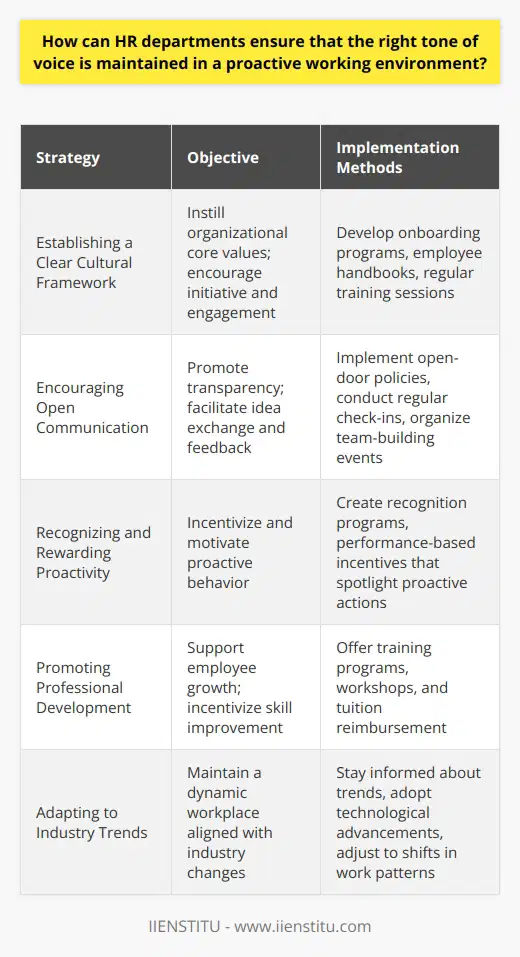
What are the key differences between reactive and proactive human resource management?
Introduction
Reactive and proactive human resource management (HRM) are two approaches organizations use to enhance their workforce performance. They differ in terms of their focus, goals, and implementation strategies.
Focus on Immediate vs. Long-term Needs
Reactive HRM addresses immediate problems and concerns within the organization. It involves dealing with current issues such as employee grievances, staff shortages, or other personnel-related challenges. In contrast, proactive HRM anticipates future needs and focuses on long-term goals, such as workforce planning, succession planning, and employee development.
Problem-solving vs. Strategic Planning
In reactive HRM, the emphasis is on problem-solving by responding to urgent situations and resolving them quickly. However, this approach often leads to short-term solutions and may neglect the broader implications of the problem. Proactive HRM, on the other hand, involves strategic planning to anticipate and prevent problems from occurring. This approach allows organizations to create more sustainable solutions and minimize potential disruptions.
Temporal vs. Continuous Approach
Reactive HRM is typically initiated in response to specific events or incidents, making it a time-bound process. Once the issue is resolved, HR may return to its normal functioning. Proactive HRM, however, is a continuous process aimed at fostering organizational growth and success. HR departments implementing this strategy take ongoing initiatives to identify opportunities, risks, and potential improvements related to human capital management.
Performance Improvement vs. Organizational Development
While reactive HRM is primarily focused on addressing the symptoms of personnel-related problems, proactive HRM seeks to address the root causes and prevent them from reoccurring. Consequently, proactive HRM approaches lead to better performance improvements and promote overall organizational development in addition to resolving immediate issues.
Adaptive vs. Innovative Mindset
Lastly, reactive HRM tends to be characterized by an adaptive mindset - adapting to challenges and situations that arise within the organization. Proactive HRM, conversely, fosters a culture of innovation, encouraging employees to explore new ideas, adopt new technologies, and continuously improve processes to ensure long-term success.
Conclusion
In conclusion, reactive and proactive HRM differ in their focus, goals, implementation strategies, and overall impact on the organization. While reactive HRM is useful for addressing immediate problems, proactive HRM helps organizations to prevent such issues, drive growth, and foster a culture of innovation. Thus, organizations aiming for sustainable success should prioritize adopting a proactive HRM approach.
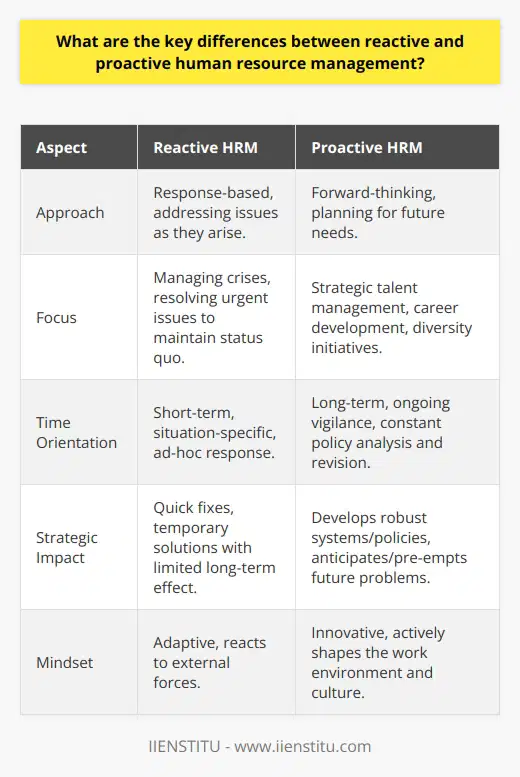
How can HR professionals identify opportunities for proactivity within their organization?
Identifying Opportunities for Proactivity
Assessing Organization's Needs
To identify opportunities for proactivity within an organization, HR professionals should first conduct a comprehensive assessment of their organization's current and future needs. This may involve recognizing skills gaps, addressing employee turnover, or analyzing the workforce's performance metrics.
Understanding Industry Trends
Furthermore, HR professionals must be aware of industry trends and anticipate changes that may impact their organization. By staying up-to-date with relevant developments, they can adopt proactive strategies that cater to shifts in the business landscape, ensuring continued success.
Employee Engagement and Feedback
Actively engaging employees and seeking their feedback is another crucial step for HR professionals trying to identify proactivity opportunities. Gathering input from employees can provide valuable insight into ways of improving processes, boosting morale, and promoting growth.
Utilizing Predictive Analytics
Leveraging predictive analytics in HR processes can enable professionals to detect and act upon patterns and correlations that might otherwise go unnoticed. These insights can pave the way for proactive measures to be taken in areas such as talent acquisition, retention, and succession planning.
Networking with Peers
Networking within the HR community and participating in professional development events can provide opportunities for HR professionals to learn about best practices, share experiences, and uncover new methods for promoting proactivity within their organizations. Collaborating with their peers can inspire innovative approaches that contribute to the organization's overall progress.
Linking HR Initiatives to Business Needs
To identify proactivity opportunities, HR professionals must ensure that their initiatives are strategically aligned with organizational goals. This involves developing a strong understanding of the organization's mission, vision, and values, and ensuring that all HR practices contribute to the achievement of these objectives.
Tailoring Strategies to Employee Needs
Finally, HR professionals must consider the unique needs and preferences of their employees when implementing proactive initiatives. Offering tailored programs and support that respects individual employee motivations, career goals, and personal circumstances ensures that everyone is empowered to reach their full potential.
In conclusion, HR professionals can identify opportunities for proactivity within their organizations by assessing needs, understanding industry trends, engaging employees, utilizing predictive analytics, networking, aligning HR initiatives with organizational goals, and tailoring strategies to employee needs. Through these actions, HR professionals can effectively contribute to their organization's growth and success.
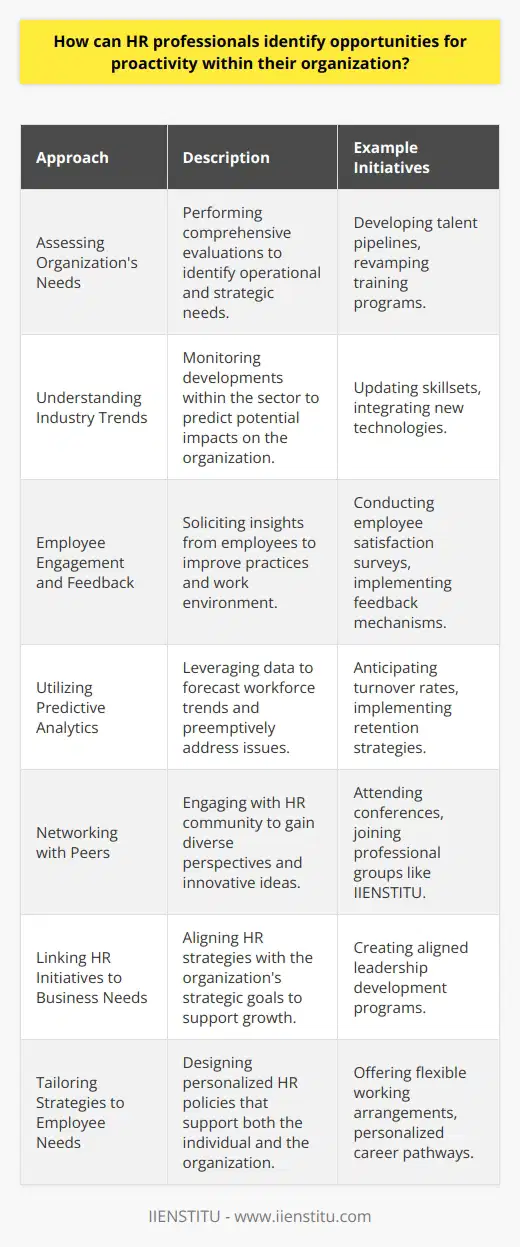
What role does effective communication play in facilitating a proactive approach to human resource management?
Role of Effective Communication
Effective communication plays a crucial role in facilitating a proactive approach to human resource management. It enables HR professionals to identify potential challenges and take timely actions, ensuring a smooth functioning workplace.
Information Sharing and Transparency
One of the primary aspects of effective communication is the flow of accurate, relevant, and timely information among employees and different departments. Such dissemination of information fosters collaboration and innovation, leading to increased efficiency.
Feedback Mechanisms
Regular feedback mechanisms, both within teams and from management to employees, are essential for continuous improvement. Through open communication channels, employees can efficiently share their thoughts, concerns, and suggestions for improvement, resulting in a more engaged workforce.
Conflict Resolution
Inevitably, conflicts arise in any workplace, but effective communication allows for quicker and more satisfactory resolutions. By promoting empathy, understanding, and active listening, a proactive HR management approach can prevent disputes from escalating and harming workplace relationships.
Employee Engagement and Satisfaction
An open and honest communication environment encourages employees to express their opinions and ideas freely, giving them a sense of ownership and belonging in the organization. In turn, this increases employee satisfaction, motivation, and overall engagement, leading to better retention rates and a more cohesive work environment.
Training and Skill Development
Effective communication also plays a vital role in identifying training needs and delivering skill development programs. By conducting regular performance evaluations, HR professionals can design targeted training interventions, ultimately contributing to employee growth and organizational success.
Change Management
Implementing change in an organization can be challenging. However, through transparent communication and inclusive decision-making processes, HR professionals can facilitate a smoother transition for employees, increasing their adaptability and acceptance of the changes.
In conclusion, effective communication is a key element in successful human resource management. By fostering open dialogue, feedback, and collaboration, HR professionals can cultivate a proactive, efficient, and satisfying work environment for all employees.
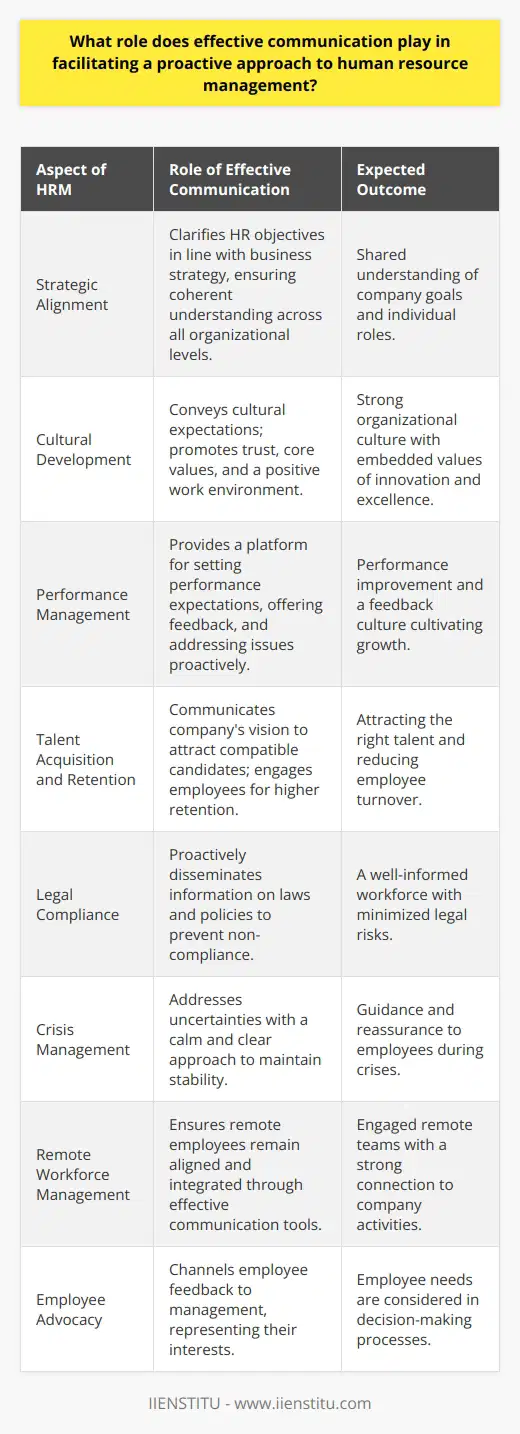
What strategies can HR professionals implement to transition from a reactive to proactive approach in addressing employee concerns and needs?
**Shifting HR Mindset and Prioritizing Employee Engagement**
To transition from a reactive to proactive approach in addressing employee concerns and needs, HR professionals must first shift their mindset to prioritize employee engagement. This involves recognizing that satisfied, motivated, and engaged employees are crucial to the success of the organization. To achieve this objective, HR professionals should employ several strategies.
**Implementing Regular Communication Channels**
Establishing regular communication channels with employees can help HR professionals stay informed about employee concerns and needs before they escalate into bigger issues. This can involve conducting monthly one-on-one check-ins, facilitating town hall meetings, or implementing pulse surveys to gather feedback on specific issues.
**Encouraging Open-Door Policies and Feedback Culture**
By fostering an open-door policy and promoting a culture of giving and receiving feedback, HR professionals can create an environment where employees feel comfortable discussing their concerns and needs. Moreover, transparent communication channels pave the way for employees to contribute ideas and feel empowered, ultimately leading to higher engagement and satisfaction levels.
**Developing Employee-Focused Policies and Programs**
Proactively addressing employee needs requires developing and implementing policies and programs that focus on the well-being and growth of employees. This may include initiatives such as training and development programs, wellness initiatives, or diversity and inclusion efforts. Through these policies and programs, HR professionals can create a supportive environment that anticipates and addresses employee needs, thereby improving overall engagement and satisfaction.
**Utilizing Data Analytics for Early Detection of Issues**
HR professionals can leverage data analytics to monitor and predict employee concerns before they escalate. Analyzing employee performance, attrition rates, and diversity statistics can reveal patterns or signs of potential issues early on, allowing HR to intervene proactively rather than reactively.
**Fostering Manager-Employee Relationships**
Encouraging and empowering managers to build strong relationships with their teams is an essential component of a proactive HR approach. Training managers to recognize the value of employee feedback and guide them on soliciting valuable insights can further improve employee engagement and address concerns before they become problematic.
In conclusion, a proactive HR approach entails prioritizing employee engagement, fostering open communication, developing employee-focused policies and programs, utilizing data analytics, and strengthening manager-employee relationships. By implementing these strategies, HR professionals can successfully shift from a reactive to a proactive approach in addressing employee concerns and needs, ultimately leading to higher levels of satisfaction and engagement within the organization.
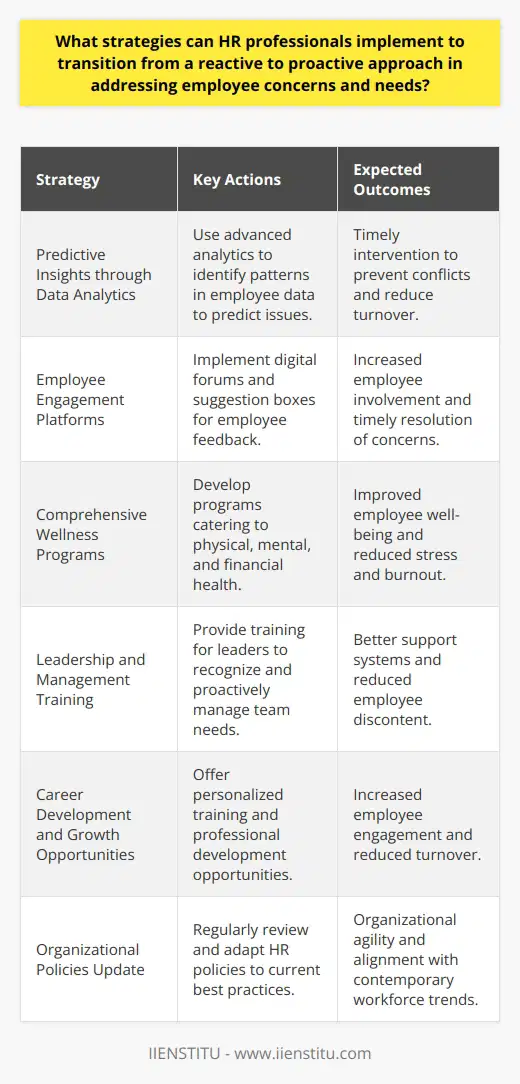
How can technology and data analytics enable HR specialists to become more proactive in their decision-making and planning processes?
Leveraging Technology in HR Decision-Making
The integration of technology and data analytics can significantly enhance the decision-making and planning capabilities of human resources (HR) specialists. By utilizing various technological tools and platforms, HR professionals can streamline their processes, identify potential issues before they escalate, and make evidence-based decisions in a timely manner.
Harnessing Data Analytics for Informed Decisions
Data analytics plays a vital role in empowering HR specialists to make well-informed decisions. Through the analysis of historical and current data, HR professionals can identify patterns and trends that may impact the organization's workforce. This information can then be used to take proactive steps in recruitment, performance management, and employee engagement, leading to improved efficiency and effectiveness.
Utilizing Artificial Intelligence for Enhanced Efficiency
Artificial intelligence (AI) is another powerful tool that can aid HR professionals in becoming more proactive in decision-making. AI-driven platforms enable the automation of tasks such as candidate screening, skills assessment, and employee onboarding. By automating these processes, HR specialists can devote more time to strategic planning and other high-value activities that contribute to the overall organizational success.
Embracing Predictive Analytics for Robust Planning
Predictive analytics is an advanced form of data analysis that can help HR professionals forecast potential future trends and challenges. Armed with this knowledge, HR specialists can develop strategies to address these challenges proactively, such as implementing new training programs, revising recruitment processes, or launching employee retention initiatives. This ultimately leads to a more resilient and adaptive workforce.
Leveraging Machine Learning for Continuous Improvement
Machine learning, a subset of AI, can greatly contribute to the continuous improvement of HR decision-making and planning. By learning from previous experiences and refining the algorithms, machine learning systems can adapt their predictions and recommendations over time. This allows HR specialists to further fine-tune their strategies and ensure they align with the ever-changing needs of the organization and its employees.
In conclusion, the incorporation of technology and data analytics into HR processes enables HR specialists to become more proactive and efficient in their decision-making and planning. The insights gained through these tools provide valuable information that drives strategic and consequential actions, ultimately leading to a robust and responsive workforce that contributes to the overall success of the organization.
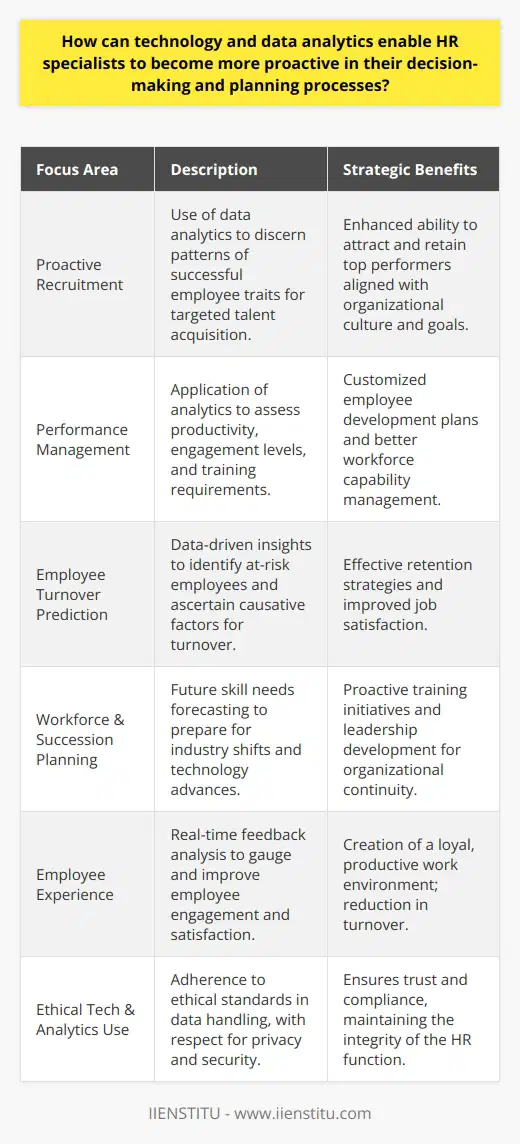
In what ways can fostering a culture of continuous learning and development contribute to proactive human resource management?
Enhancing Employee Skills and Knowledge
Fostering a culture of continuous learning and development can contribute to proactive human resource management in several ways. Firstly, it promotes the enhancement of employee skills and knowledge. By encouraging employees to develop new abilities, organizations can equip their workforce to better adapt to changing business environments and technologies.
Increased Employee Engagement
Continuous learning and development can also increase employee engagement. When employees feel supported in their professional growth, they are more likely to show commitment and dedication to their job. This, in turn, translates into higher job satisfaction levels, which can result in greater employee retention and a more motivated workforce.
Supporting Succession Planning
A culture of continuous learning and development can contribute to proactive human resource management by facilitating succession planning. When employees have opportunities to improve their capabilities, organizations can identify potential leaders and future successors early in their career development. This allows businesses to prepare and groom these individuals for higher responsibilities and reduces the risks associated with unplanned personnel changes.
Attracting Top Talent
Emphasizing ongoing learning and development can also help organizations attract top talent. Job seekers today seek not only competitive salaries but also opportunities for professional growth. An organization that provides development programs is more likely to attract high-quality candidates, contributing to a stronger and more competent workforce.
Promoting Innovation and Problem-Solving
Continuous learning fosters a climate of innovation and problem-solving, allowing organizations to stay competitive in the evolving business landscape. Employees who develop new skills and knowledge are more likely to bring fresh perspectives to their roles, contributing to enhanced organizational performance.
In conclusion, fostering a culture of continuous learning and development can lead to various benefits for proactive human resource management, such as enhancing employee skills, increasing engagement, supporting succession planning, attracting top talent, and promoting innovation. By investing in employee development, organizations can build a resilient and adaptable workforce capable of meeting current and future challenges.
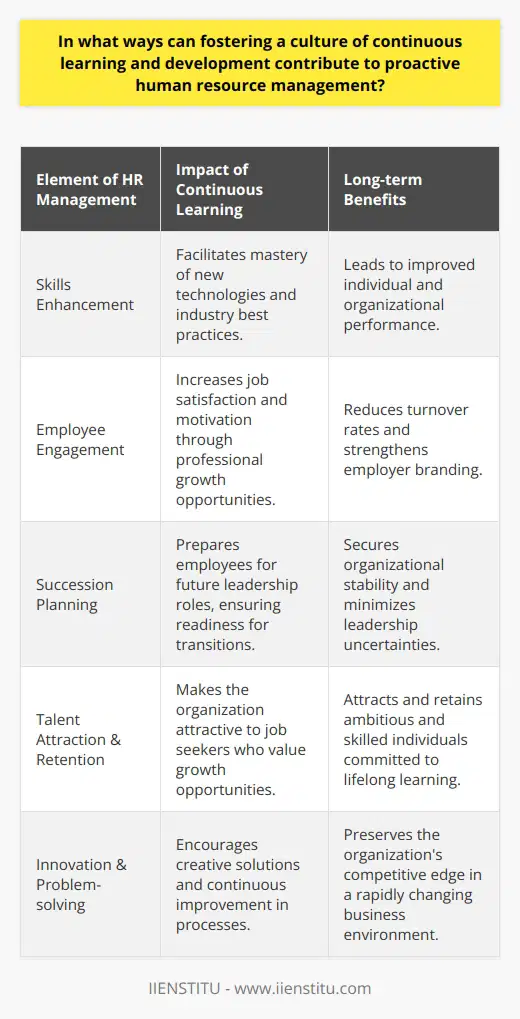
What are the essential skills and competencies required for an HR specialist to effectively adopt a proactive approach in their role?
Essential Skills for Proactivity
An HR specialist's ability to adopt a proactive approach in their role is contingent upon a combination of essential skills and competencies. These abilities enable HR professionals to anticipate, identify, and address potential issues before they escalate, thus ensuring a smooth and efficient workforce.
Emotional Intelligence
Emotional intelligence is central to the HR role, as it allows specialists to understand, manage, and respond effectively to individual and collective emotions. By fostering empathy and self-awareness, HR specialists can empathize with employees, anticipate their needs, and proactively resolve conflicts that may arise.
Communication Skills
Strong verbal and non-verbal communication skills are essential for an HR specialist. The ability to articulate ideas and convey messages clearly, both in writing and speaking, helps ensure the effective transmission of policies, procedures, and expectations. Moreover, active listening skills are crucial for understanding challenges and adapting accordingly.
Problem-solving Abilities
Proactive HR specialists identify potential problems before they arise and develop measures to prevent or mitigate their impact. The ability to utilize critical thinking, analyze scenarios, and apply relevant strategies is indispensable for preventing future workplace issues.
Strategic Planning
Effective strategic planning helps HR specialists advance organizational goals by allocating resources and aligning efforts. This competency allows them to anticipate future workforce needs and develop appropriate plans and policies, in turn, creating an environment where employees can thrive.
Data-driven Decision Making
Harnessing the power of data analytics, HR specialists can identify trends and patterns that may impact employee productivity and satisfaction. This competency enables them to make evidence-based decisions, thus minimizing the gap between current workforce capabilities and desired outcomes.
Change Management
In the ever-evolving business landscape, the ability to manage change is crucial for HR specialists. Proactively preparing and guiding employees through organizational change instills resilience and fosters a more adaptable workforce.
Relationship Building
Cultivating strong relationships with both employees and management is key to ensuring the HR function operates optimally. Trust, mutual respect, and open communication facilitated by HR specialists are essential for creating a unified and engaged workforce.
In conclusion, possessing a diverse skill set and a strong foundation in emotional intelligence, communication, strategic planning, and other relevant competencies is essential for HR specialists to adopt a proactive approach. Developing these skills enables them to anticipate, identify, and prevent workforce challenges, ensuring the efficient functioning of the organization.
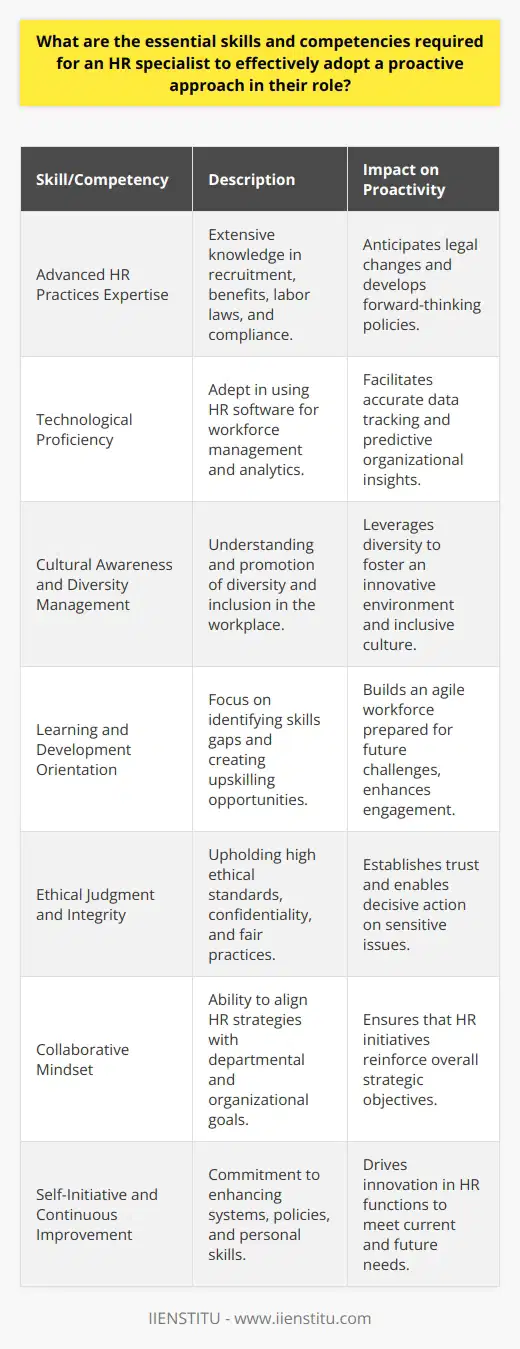
How can an HR professional leverage their understanding of organizational culture, values, and goals to promote proactive human resource management?
Understanding Organizational Culture
An HR professional can leverage their understanding of organizational culture by closely analyzing the values, beliefs, and norms that drive employees' behavior. By fostering a healthy organizational culture, HR can improve employee engagement, productivity, and retention. This includes recognizing and promoting the values that resonate with employees, which may involve creating or adjusting policies, programs, and practices specific to the organization.
Aligning HR Activities with Organizational Goals
To promote proactive human resource management, HR professionals should ensure that their activities are aligned with the organization's goals. This can be done by collaborating with leaders to identify the company's objectives and proactively work to achieve them. By integrating these objectives into HR activities such as recruitment, onboarding, and performance management, HR can contribute to the overall success of the organization.
Fostering Learning and Development Opportunities
Supporting employee skill development is another vital aspect of proactive human resource management. HR professionals can leverage their understanding of company values and goals to design and implement learning and development programs tailored for the organization's needs. By facilitating continuous learning opportunities, HR can help employees enhance their skills, adapt to changing business demands, and align their performance with the company's strategic goals.
Promoting Employee Engagement and Satisfaction
Understanding the organizational culture allows HR professionals to enact strategies that increase employee engagement and satisfaction. By recognizing and addressing individual employees' needs and values, HR can create initiatives that cater to what matters most to employees. This includes fostering a culture of trust, open communication, and recognition, as well as offering flexibility, competitive benefits, career growth opportunities, and work-life balance.
In conclusion, an HR professional's understanding of organizational culture, values, and goals is instrumental in promoting proactive human resource management. By fostering a positive organizational culture, aligning HR activities with company objectives, supporting employee development, and driving employee engagement and satisfaction, HR professionals can play a significant role in an organization's success.
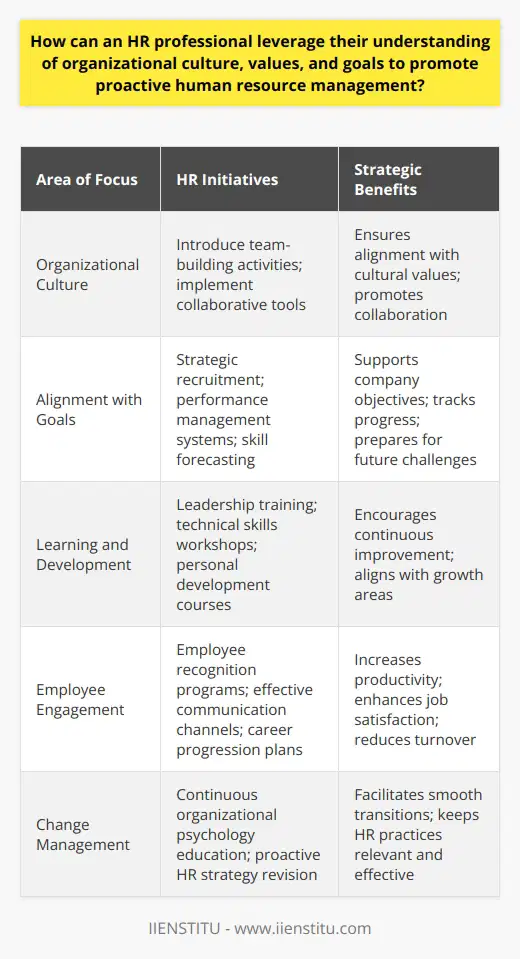
In what ways can collaboration between different departments and teams within an organization contribute to more proactive HR practices and outcomes?
Enhancing Interdepartmental Coordination
Collaboration between different departments and teams within an organization holds significant potential for contributing to proactive HR practices and outcomes. Firstly, strong interdepartmental coordination fosters effective knowledge sharing. By leveraging cross-functional expertise and experience, HR professionals can identify skill gaps and develop targeted training and development programs that align with the company's objectives.
Building an Integrated HR Approach
Collaborative efforts also enable departments to develop a more comprehensive understanding of employees' needs and requirements. Through joint initiatives and activities, HR can gather valuable insights and perspectives, leading to the design and implementation of programs that resonate with employees across the organization. This integrated approach ensures all staff members receive appropriate levels of support and resources, enhancing employee satisfaction and maximizing productivity.
Streamlining Decision-Making Processes
Another advantage of interdepartmental collaboration lies in the streamlining of decision-making processes. As teams work together to create well-informed strategies, HR can address pressing issues and challenges more quickly and effectively. In turn, this can result in the smooth execution of organizational changes and prompt resolution of potential conflicts or crises, minimizing any negative effects on employee wellbeing.
Promoting a Supportive Work Environment
Finally, fostering collaboration between various departments and teams helps create a culture of open communication and mutual understanding, which is critical for the success of any HR practice. Employees are more likely to feel engaged, valued, and appreciated in a supportive work environment. Subsequently, this cultivates a sense of belonging and commitment to the organization, leading to higher retention rates and attracting top talent.
In summary, interdepartmental collaboration within an organization greatly contributes to proactive HR practices and outcomes. Through effective information sharing, understanding employees' perspectives, streamlining decision-making processes, and cultivating a positive work environment, HR can create programs and strategies that lead to a productive and satisfied workforce.
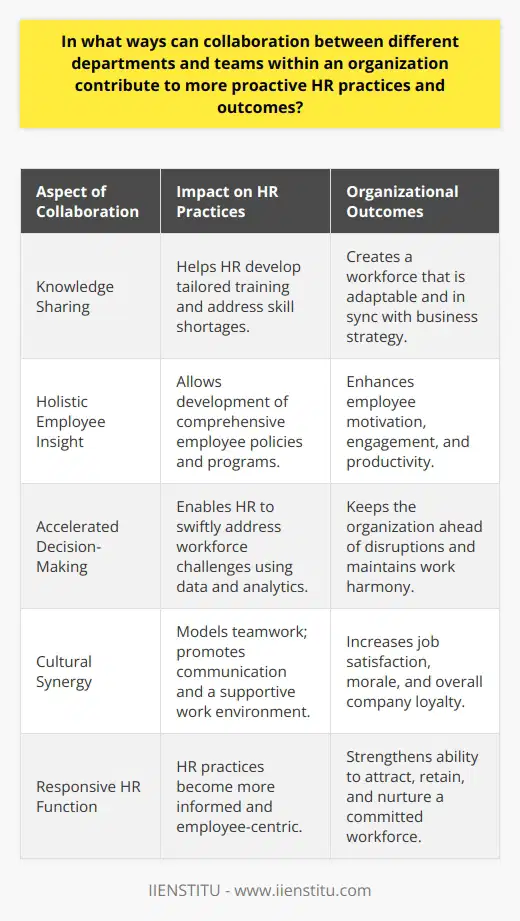
What is the role of strategic planning in enabling HR professionals to transition from reactive to proactive human resource management?
Role of Strategic Planning
Strategic planning plays a crucial role in enabling HR professionals to make a transition from reactive to proactive human resource management. By establishing a well-defined vision, mission, and goals, HR professionals can effectively anticipate workforce trends, identify emerging skills gaps, and devise strategies to develop and retain talent.
Anticipating Workforce Trends
Through strategic planning, HR professionals are better equipped to analyze potential shifts in the labor market, such as changes in demographics, technological advancements, or shifting global economic conditions. This allows them to proactively adapt their recruitment and retention strategies, subsequently ensuring a continuous supply of appropriately skilled employees.
Identifying Emerging Skills Gaps
Being proactive, HR professionals can identify or predict skills gaps within the organization by aligning their understanding of emerging market trends, technological advancements, and employee skills. This enables them to develop targeted training and development programs that empower employees with relevant skills and knowledge, ultimately contributing to the organization's competitive advantage.
Devising Solutions for Retention
By analyzing trends and predicting how these may impact employee motivations and expectations, HR professionals are better positioned to develop tailored retention strategies that address the anticipated needs and aspirations of the workforce. This includes the creation of competitive compensation and benefits packages, as well as offering ample opportunities for career advancement and personal growth.
Implementing Succession Planning
Proactive HR management also involves succession planning, ensuring that the organization is prepared for any unplanned leadership turnover or workforce fluctuations. By identifying and nurturing potential leaders, HR professionals can ensure a smooth transition and minimal disruption to business continuity.
In conclusion, the role of strategic planning in enabling HR professionals to transition from reactive to proactive human resource management is multifaceted. By anticipating workforce trends, identifying emerging skills gaps, devising solutions for retention, and implementing succession planning, HR professionals can better serve the dynamic needs of their organization, and drive sustainable growth and success.
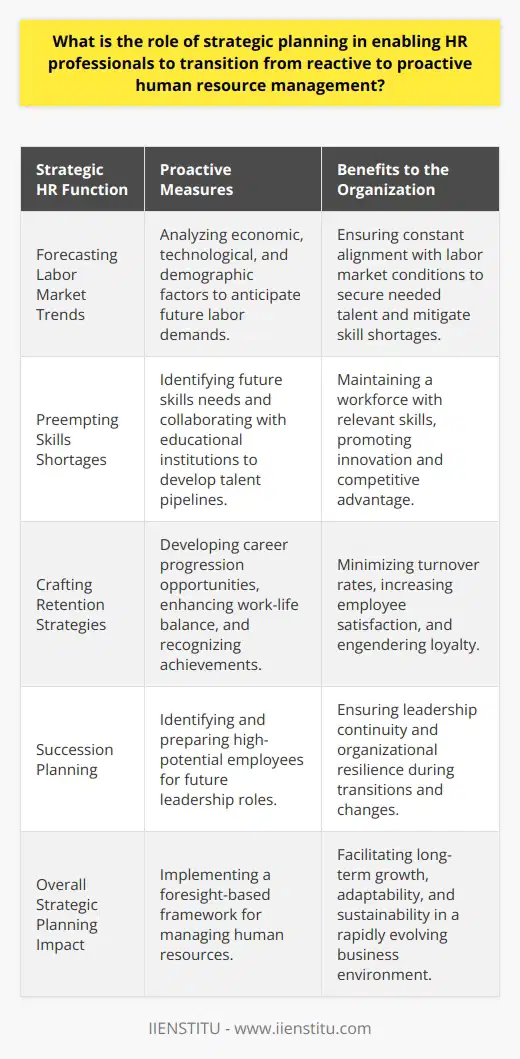
How can an HR specialist leverage performance management tools and techniques to facilitate proactivity in addressing employee development and engagement?
Performance Management Techniques for Proactivity
An HR specialist can leverage performance management tools and techniques to facilitate proactivity in addressing employee development and engagement through various ways. Firstly, by setting clear expectations and objectives for employees, HR can create a results-driven environment that enables individuals to take charge of their growth.
Regular Performance Reviews
Regular performance reviews play a critical role in fostering proactivity. By providing constructive feedback and aligning employee performance to organizational goals, HR specialists can empower employees to identify areas of improvement and take decisive action. This process not only aids in their personal development but also contributes to the overall success of the organization.
Goal Setting and Alignment
Goal setting and alignment are essential components of proactive employee development. HR specialists should work hand in hand with employees in establishing SMART (Specific, Measurable, Achievable, Relevant, and Time-bound) goals that are directly linked to organizational objectives. This method ensures that employees are engaged in their roles and actively contribute to the organization's strategic direction.
Continuous Learning Opportunities
Providing continuous learning and development opportunities can also promote proactivity in employees. HR specialists should create an environment that encourages knowledge sharing, skill acquisition, and collaboration. This can be achieved through training programs, workshops, or online resources that address skill gaps and cater to individual learning styles.
Recognition and Reward Programs
Implementing recognition and reward programs can boost employee engagement and encourage proactive behavior. HR specialists must ensure that employees' achievements and contributions are acknowledged and rewarded, reinforcing the connection between performance and organizational success. This ultimately motivates employees to take ownership of their performance and seek opportunities for growth.
In conclusion, HR specialists can effectively facilitate proactivity in employee development and engagement by employing performance management tools and techniques. By setting clear expectations, conducting regular performance reviews, aligning goals, offering continuous learning opportunities, and implementing recognition and reward programs, HR professionals can foster an environment where employees are motivated to take charge of their growth and contribute to the organization's success.
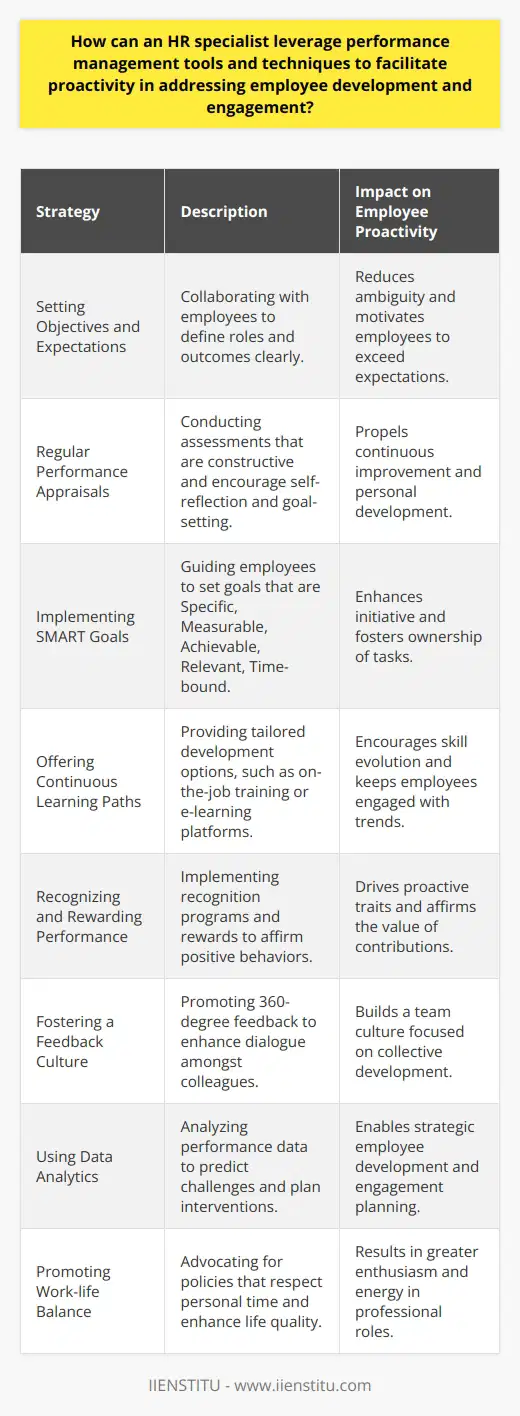
In the context of talent acquisition and retention, what strategies can be employed by HR professionals to adopt a more proactive approach towards staffing and workforce planning?
Proactive Recruitment Techniques
To adopt a more proactive approach towards staffing and workforce planning, HR professionals can employ various strategies for talent acquisition and retention. First, they can use data analytics to predict future hiring needs, allowing them to identify and target talent before positions become open. This may involve analyzing workforce trends and industry-specific projections to anticipate skill gaps or demographic shifts.
Building Talent Pipelines
Another strategy involves building talent pipelines for critical roles using talent pools. HR professionals can maintain relationships with potential candidates through networking, industry events, and online platforms. This approach enables organizations to have a constant flow of prospective employees who are familiar with their corporate culture and values.
Leveraging Employer Branding
Employer branding plays a crucial role in attracting and retaining top talent. HR professionals can work to create a compelling and authentic employer value proposition. This includes showcasing the organization's unique culture, career development opportunities, and overall employee experience. A strong employer brand will not only attract potential candidates but also contribute to employee loyalty and retention.
Employee Development and Retention
Investing in employee development and retention is essential to proactively managing workforce planning. HR professionals can focus on offering continuous learning opportunities, mentoring programs, and clear career progression paths for employees. These initiatives will result in both existing and potential employees perceiving the organization as a desirable work environment that offers growth and long-term potential.
Embracing Flexible Work Arrangements
Finally, embracing flexible work arrangements can also contribute to a proactive approach to talent acquisition and retention. By offering options such as remote work, flexible hours, and job sharing, organizations can attract a broad range of candidates and accommodate diverse employee needs. HR professionals can be instrumental in developing and implementing these policies, ensuring that the organization remains attractive to current and prospective talent.
In conclusion, adopting a more proactive approach in workforce planning requires HR professionals to anticipate future talent needs, build talent pipelines, leverage employer branding, invest in employee development, and provide flexible work arrangements. These strategies will serve to not only attract the best talent but also retain valued employees, ensuring the organization's long-term success.
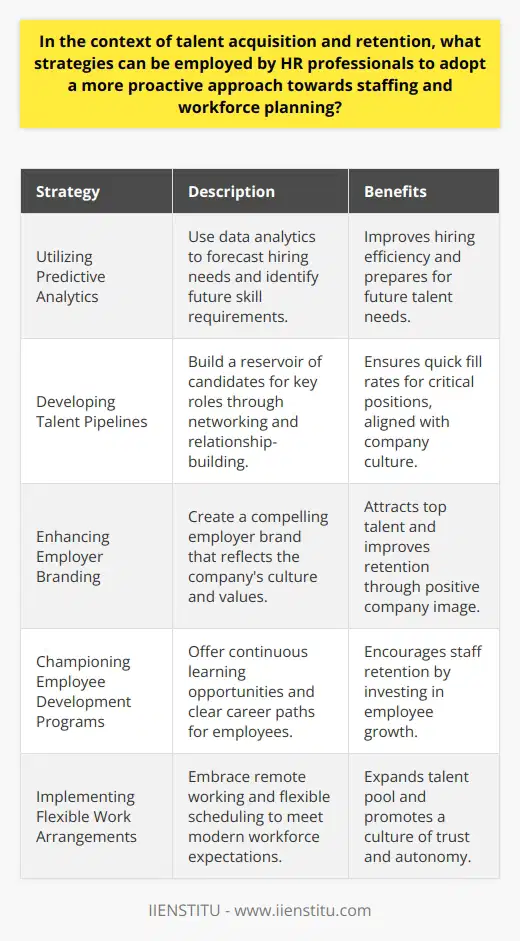
What are the critical components necessary for developing a proactive HR strategy within an organization?
Identifying Key Components
A proactive HR strategy is essential for an organization's overall success. To develop a robust plan, it is important to examine the critical components that encompass an effective approach to human resources management. These components can be categorized as follows:
Organizational Goals and Objectives
First and foremost, the HR strategy should be aligned with the organization's goals and objectives. This allows HR professionals to create policies and programs that support the organization's overall mission, which in turn fosters a cohesive work environment.
Workforce Planning and Talent Acquisition
Effective workforce planning involves understanding the present and future needs of the organization. By anticipating future workforce requirements, HR professionals can proactively recruit and attract talent, which is crucial for maintaining a competitive edge in the marketplace.
Employee Development and Training
Employee development and training programs are the backbone of an effective HR strategy. These initiatives empower employees to enhance their skills and adapt to changes within the industry, ensuring that the organization remains innovative and agile in an ever-changing environment.
Performance Management
A robust performance management system enables HR professionals to track employees' progress and accomplishments, identify areas for improvement, and provide regular feedback. This component of a proactive HR strategy ensures employees are engaged and feel appreciated for their work.
Employee Engagement and Retention
Ultimately, a proactive HR strategy should focus on enhancing employee engagement and retention. This can be achieved through implementing employee recognition programs, providing opportunities for professional growth, and maintaining open lines of communication between employees and management.
Inclusive Workplace Culture
A proactive HR strategy must consider creating a diverse, equitable, and inclusive workplace culture. This includes implementing policies and practices that promote diversity and ensure a fair hiring process, as well as providing resources and support for underrepresented employees.
Legal and Regulatory Compliance
Lastly, staying compliant with legal and regulatory requirements is essential for an effective HR strategy. HR professionals must have a thorough understanding of employment laws and regulations to protect the organization from potential legal disputes and fines.
In conclusion, developing a proactive HR strategy within an organization requires a comprehensive approach that addresses various components such as organizational goals, workforce planning, talent acquisition, employee development, performance management, employee engagement, workplace culture, and legal compliance. With these core components in place, an organization can unlock its full potential, ultimately ensuring a successful and prosperous future.
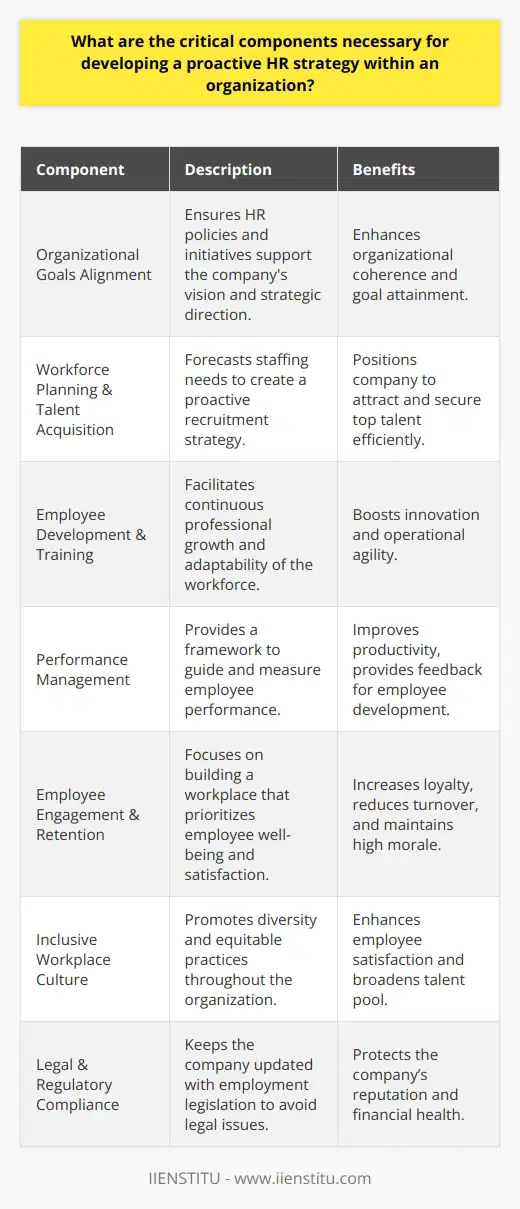
How can an HR specialist utilize employee feedback and engagement data to foster a proactive approach to human resource management?
Understanding Employee Feedback
An HR specialist can foster a proactive approach to human resource management by understanding employee feedback and engagement data. Employee feedback can provide valuable insights into employee satisfaction, workplace culture, and overall organizational health. HR specialists can use feedback to identify areas of improvement and to develop targeted initiatives aimed at boosting employee engagement and productivity.
Leveraging Engagement Data
Engagement data is a vital component of proactive human resource management, as it reveals the extent to which employees are committed to and involved in their work. By analyzing engagement data, HR specialists can pinpoint specific factors leading to high or low engagement levels, identify trends, and develop strategies to improve engagement across the organization. This data-driven approach enables HR professionals to prioritize resources and interventions, ensuring that their efforts have the greatest possible impact.
Implementing Positive Changes
Once areas for improvement have been identified through employee feedback and engagement data, HR specialists must take the necessary steps to implement positive changes within the organization. This may involve improving communication channels, offering training or development opportunities, and creating a more inclusive and supportive work environment. By addressing the root causes of employee dissatisfaction and disengagement, HR specialists can foster a proactive approach to human resource management that benefits the entire organization.
Monitoring and Evaluation
Finally, to ensure the effectiveness of their efforts, HR specialists should regularly monitor and evaluate the impacts of implemented changes. This can be accomplished through ongoing employee surveys, focus groups, and engagement metrics. Continuous assessment allows HR specialists to refine their strategies and remain responsive to the evolving needs of employees, ultimately contributing to the long-term success of the organization.
In conclusion, HR specialists can utilize employee feedback and engagement data to foster a proactive approach to human resource management by understanding employee needs, leveraging engagement data to prioritize interventions, implementing positive changes, and continuously monitoring their effectiveness. By doing so, HR professionals contribute to the overall productivity, satisfaction, and success of the organization.
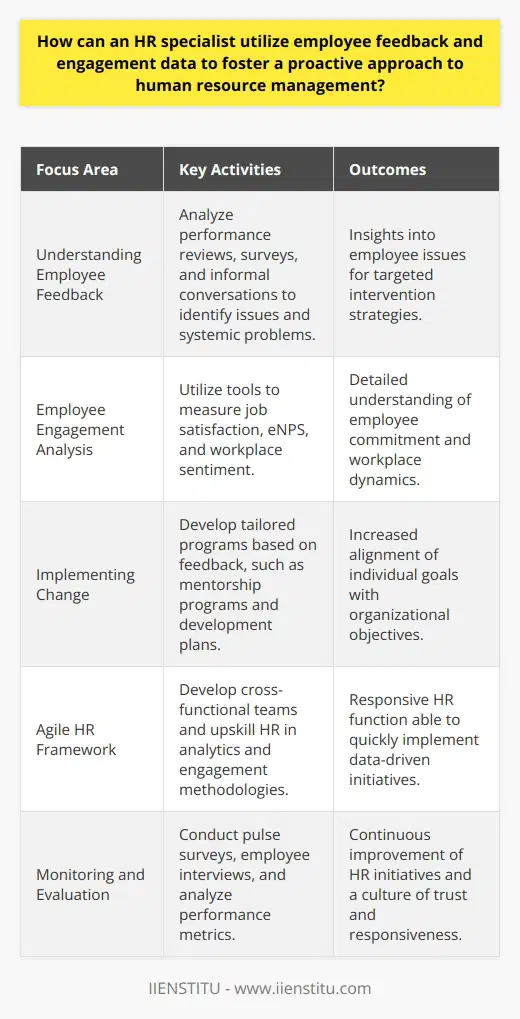
In what ways can an HR professional effectively manage change within an organization to enable a shift from reactive to proactive human resource management?
Understanding the Change Process
To effectively manage change within an organization, HR professionals must first understand the change process and how it impacts the workforce. This involves recognizing the key factors driving change, such as the adoption of new technology or shifting market conditions, and how these factors influence the organization's overall strategic goals. By gaining a clear understanding of the change process, HR professionals can better anticipate the impact on employees and ensure that their needs are adequately addressed throughout the transition.
Active Participation in Change Initiatives
An essential aspect of proactive HR management is actively participating in change initiatives, rather than merely reacting to them. HR professionals should collaborate with other organizational departments, such as IT and finance, to develop a comprehensive understanding of the change requirements and to create a strategic approach for implementation. By working closely with cross-functional teams, HR professionals can identify potential challenges and develop solutions that support the successful management of change and minimize potential disruptions to organizational processes.
Effective Communication and Transparency
HR professionals play a critical role in facilitating effective communication throughout the change management process. This involves ensuring transparency by sharing timely, accurate information about the change initiatives and how they will impact employees. Open, honest communication fosters trust among employees and allows them to voice concerns, ask questions, and offer suggestions, which are essential to the success of any change effort. By maintaining open lines of communication, HR professionals can better address employee needs and promote a sense of ownership and engagement in the change process.
Employee Training and Development
To enable employees to adapt successfully to change, HR professionals should prioritize the provision of appropriate training and development opportunities. By equipping employees with the necessary skills and knowledge to navigate the new organizational landscape, HR professionals can facilitate a smoother transition to a proactive HR management approach. This may include offering in-house training, providing access to external courses, or implementing mentorship programs that provide employees with the support and resources they need during the change process.
Conclusion
In summary, by focusing on understanding the change process, actively participating in change initiatives, promoting effective communication and transparency, and providing employee training and development opportunities, HR professionals can effectively manage change within an organization. This proactive approach to HR management benefits the entire organization by promoting employee engagement, minimizing disruptions, and fostering a more agile, responsive workforce that can readily adapt to new challenges and opportunities.

